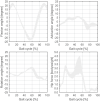Polyethylene wear of dual mobility cups: a comparative analysis based on patient-specific finite element modeling
- PMID: 35020024
- PMCID: PMC8930956
- DOI: 10.1007/s00264-022-05305-4
Polyethylene wear of dual mobility cups: a comparative analysis based on patient-specific finite element modeling
Abstract
Purpose: Concerns remain about potential increased wear with dual mobility cups related to the multiple articulations involved in this specific design of implant. This finite element analysis study aimed to compare polyethylene (PE) wear between dual mobility cup and conventional acetabular component, and between the use of conventional ultra-high molecular weight PE (UHMWPE) and highly cross-linked PE (XPLE).
Methods: Patient-specific finite element modeling was developed for 15 patients undergoing primary total hip arthroplasty (THA). Five acetabular components were 3D modeled and compared in THA constructs replicating existing implants: a dual mobility cup with a 22.2-mm-diameter femoral head against UHMWPE or XLPE (DM22PE or DM22XL), a conventional cup with a 22.2-mm-diameter femoral head against UHMWPE (SD22PE) and a conventional cup with a 32-mm-diameter femoral head against UHMWPE or XLPE (SD32PE or SD32XL).
Results: DM22PE produced 4.6 times and 5.1 times more volumetric wear than SD32XL and DM22XL (p < 0.0001, Cohen's d = 6.97 and 7.11; respectively). However, even if significant, the differences in volumetric wear between DM22XL and SD32XL as well as between DM22PE and SD22PE or SD32PE were small according to their effect size (p < 0.0001, Cohen's |d|= 0.48 to 0.65) and could be therefore considered as clinically negligible.
Conclusion: When using XLPE instead of UHMWPE, dual mobility cup with a 22.2-mm-diameter femoral head produced a similar amount of volumetric wear than conventional acetabular component with a 32-mm-diameter femoral head against XLPE. Therefore, XLPE is advocated in dual mobility cup to improve its wear performance.
Keywords: Dual mobility cup; Highly cross-linked polyethylene; Patient-specific modeling; Polyethylene mobile component; Polyethylene wear.
© 2022. The Author(s).
Conflict of interest statement
JW receives royalties from Dedienne santé and serves as paid consultant for Stryker Orthopaedics and Lima corporate. AA serves as paid consultant for Stryker Orthopaedics. ES, MB and AT have no conflict of interest to disclose.
Figures






References
Publication types
MeSH terms
Substances
LinkOut - more resources
Full Text Sources
Medical

